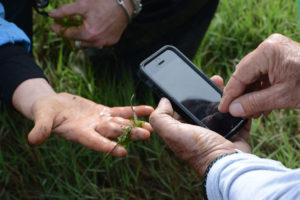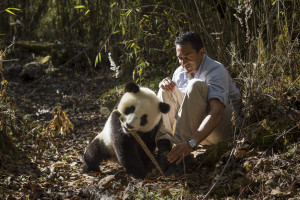At the turn of the 20th Century, the California Academy of Sciences was the oldest scientific society in the western United States. From its humble beginnings in 1853 as California’s de facto cabinet of curiosities stemming from “the systematic survey of every portion of the State,” the Academy had matured to a respected position at the forefront of the natural sciences. The Academy attracted many of the best and brightest naturalists: John Van Denburgh, Albert Kellogg, Louis Agassiz, Spencer Fullerton Baird, William Henry Brewer, Alice Eastwood, and Joseph Grinnell, to name but a few. In addition to surveying the hinterlands of California, the Academy’s accomplishments included expeditions to the Galapagos, Baja California, and inventories of the western states.
In the days before the “Great Disaster” of April 18, 1906, the Academy shelved close to 15,000 natural history volumes in addition to assorted periodicals, pamphlets, and scientific publications. The thousands of specimens and their “types,” the specimens chosen for the description and designation of each species, housed at the Academy represented 53 years of collecting since the Academy’s inception.
The magnitude 7.8 (Mw) earthquake that shook San Francisco to its core in the early hours that Wednesday morning left the Academy’s buildings on Market Street near the Emporium and the Society of Pioneer’s building relatively unscathed – an estimated $1,200 in damages and a tumbled specimen jar here or there, based on a mid-morning assessment of the damage. It was not the earthquake, however, that temporarily brought the Academy to its knees, but the fire that was to follow. As Museum Director Leverett Mills Loomis and a handful of curators navigated the rubble-strewn streets that morning toward the Academy to see if the building was in danger, the fire that was engulfing the surrounding city unchecked had begun making its way down Mission St. toward the Academy’s walls.
Upon reaching the museum, the staff found that the enclosed bridge that connected the Market Street “Front” entrance to the Museum itself-the “Rear Building”-had collapsed. According to letters later written by Alice Eastwood, the Academy’s Curator of Botany, Eastwood doubled around to the back of the building and hazarded the marble staircase with the aide of a friend “by holding on to the iron railing and putting [their] feet between the rungs.” From the departments’ and curators’ offices on the fifth and sixth floors, Eastwood saved a single personal item – her Ziess lens – and then bundled up her precious plant types and “lowered them to the floor of the museum by ropes and strings tied together.” In doing so, Eastwood was able to salvage 1,500 specimens, most of them types.
Director Loomis and Assistant Librarian/Assistant Secretary Mary E. Hyde climbed to the sixth floor and saved the Academy’s records and Theodore Henry Hittell’s manuscript documenting the history of the Academy. Meanwhile, entomology preparator Charles (Carl) Fuchs, with Hyde’s assistance, saved 264 Coleoptera, Hemiptera, and Hymenoptera type specimens, out of the entomology department’s total of some 50,000 specimens.
Not all departments were so fortunate. Of the herpetology department’s 8,100 specimens collected since 1895, curator John Van Denburgh was able to save only ten type specimens, three miscellaneous specimens, and the department’s catalog of specimens. Among those specimens saved-most of which came from Baja California, Mexico-were types of the arboreal salamander and the common side-blotched lizard, locally abundant here in the Bay Area.
Foreseeing the oncoming disaster, Loomis also rushed to the Department of Ornithology and Mammalogy and carried out the two type specimens of the now-extinct Guadalupe storm-petrel (Oceanodroma macrodactyla), with several ornithological illustrations tucked beneath his arm. By noon, the fire had reached the Academy, consuming both the Front and Rear Buildings. The remaining 25,000 bird specimens, all of the thousands of mammal specimens, the rest of the botany, entomology, and herpetology departments, and the Academy library were incinerated in the ensuing fire. When the flames died down, all that remained of the Academy was a shell of concrete, sandstone, granite, brick, iron, and steel.
Staying ahead of the fire, the Academy staff-turned-saviors carted the salvaged remains of their collections to their homes. From there, the rag-tag accumulation of type specimens were eventually moved to the vaults of the Crocker Bank. In June of 1906, the non-type specimens were relocated to the Academy’s temporary quarters at 1812 Gough Street and 345 Sansome Street.
Loomis later wrote of their endeavors, “So you see we made a beginning before the end had come.” Such beginnings manifested themselves tenfold in the weeks to come as the Academy began nursing its wounds. Undaunted, scientists like Eastwood picked up their duties where they had left off. In a letter penned a month after the earthquake, she wrote “I am beginning already to recollect [sic] and intend to go to type localities as much as possible…” Farther afield, the international scientific community rallied around the ashes of the crippled Academy to help it rebuild, book-by-book, specimen-by-specimen.
On May 8, C. Hart Merriam of the Smithsonian Institute wrote to Director Loomis. “I am anxious to know what the Academy has left to start anew with … the Biological Survey will do all in its power to help. We are now endeavoring to make up a complete set of our publications to be sent to the Academy’s library as soon as any place is available.” On May 17, The Academy of Natural Sciences of Philadelphia offered to send an appeal to foreign institutions, which was followed at the end of month by another offer of “as complete sets as possible of its publications, together with a collection of duplicate books,” totaling nearly 1800 volumes. In the end, donations of scientific publications poured in from 42 individuals, seven book dealers, 50 U.S. institutions, and 114 institutions from around the world.
When Academy members met at their temporary Gough Street headquarters on September 3, 1906, for the first time since the fire, their new collections began with the donations of a California scorpion, more than a thousand California plants, eight California land snails, a collection of Pacific Coast shells, and approximately 50 pamphlets, 343 bound volumes, some 966 unbound volumes, and 823 “parts of volumes” for the Academy’s shelves.
Several years after the earthquake, Assistant Curator of Herpetology Joseph R. Slevin reflected on the lessons learned in the wake of the fire. In his “The Making of a Scientific Collection of Reptiles and Amphibians,” Slevin wrote:
The great San Francisco fire of 1906 showed that it is unwise to keep types in… the general collections, as was done prior to that conflagration. All the types could then have been saved had they been segregated. As it was, time was not sufficient to permit the finding of all of them, and a number of types had to be left to burn.
According to Alan Leviton, the current Department of Herpetology Curator and Chair with the Academy, there’s something to be said for the number of Academy staff who ventured from the safety of their homes that day to safeguard the institution in the face of the advancing fire. Despite their valiant efforts, there is little doubt the Academy’s losses were a setback to science. For each of the specimens that were rescued, untold thousands of specimens, books, papers, and more were lost to the fire; things that were one-of-a-kind, things that have never been replaced. According to Leviton, there are no overall records of what those might have been. Of the types and non-types, “These can never be replaced” says Leviton, “even though we have collected other materials from the same localities that closely resemble materials that were lost.” How do you quantify a value-scientifically, aesthetically, monetarily-to that which has been effectively erased?
Although easily overlooked given the estimated 3,000 people said to have perished in the earthquake and fire, the scientific community- the world, really-lost more than some dusty old type specimens on that tragic day. Gone too were parts of lives; the long hours, days, months, years of the lives of those naturalists who had traveled, observed, collected, described, and recorded the then-undescribed natural world of California and its surroundings. Their notes, their specimens, their passions; all left to burn.
Of course, Alice Eastwood didn’t see it that way. On May 7, 1906, nineteen days after the earthquake, Eastwood noted: “I do not feel the loss to be mine, but it is a great loss to the scientific world and an irreparable loss to California. My own destroyed work I do not lament, for it was a joy to me while I did it and I can still have the same joy in starting it again.”
Postscript:
In 2003, the Academy celebrated its 150th anniversary, and in 2008, the Academy is scheduled to debut the “new Academy,” a 370,000 square-foot resource-efficient (“green”) facility featuring a “living roof” with seven real dirt-and-grass hills. Today, the Academy’s collections include 1.9 million plant specimens, 9.5 million processed and 4.5 million unprocessed insect and arachnid specimens, 280,000 reptile and amphibian specimens, 95,000 bird specimens, 23,000 mammal specimens, more than 2,000,000 fish specimens, 2.5 million invertebrate zoology and geology specimens, the Morrison Planetarium, and the Steinhart Aquarium (still the country’s oldest continually operating aquarium).




